Lifestyle
Elephant seals are marine mammals
 Elephant seals hauled out at Año Nuevo, California.
Photographer - Jessica Meir.
Elephant seals hauled out at Año Nuevo, California.
Photographer - Jessica Meir.

"Where do they go?" - a simple question that has been difficult to answer.
Inside this section
• Where they spend their time
• How they live
• Annual events
• Tagging programs
• The double migration
• What they eat
________________________________
With the recovery of the northern elephant seal population, increasing numbers of elephant seals congregate on local beaches where visitors see them give birth, mate, molt and snooze. But they spend most of the time, 8 to 10 months of the year, elsewhere.
What do they do when they are away? With development of affordable satellite-based tracking systems, their extreme capabilities have been revealed.
We highlight just a few aspects of an unusual lifestyle that involves very specific ways of utilizing food and space resources.
Highlights of their life

More about elephant seals -
• Friends of the Elephant Seal• California State Parks
• National Park Service - Point Reyes
• Tagging of Pacific Predators
• Big Sur Chamber of Commerce
- Double-migration: They come back to land twice a year - once to give birth and mate, and another time to shed their outer skin and fur in a process called molting.
- Long migration: They go on one of the longest migrations to forage for food, 21,000 km for males and 18,000 km for females, counting just the horizontal distance covered over two roundtrips a year.
- Complex annual schedule: They have a complex scheduling system with different age groups and sexes utilizing beach space sequentially. Space can be a limiting resource for this animal.
- Fasting: They generally fast while on land, males up to 4 months and females up to 2 months.
- Molting: They catastrophically shed their fur and epidermis once a year instead of shedding a little at a time.
- Gregarious and solitary: They are gregarious on land, but solitary at sea.
- Marine: They breathe air like all mammals, including humans, but they are adapted to living nearly entirely at sea.
- Sex-based migration differences: Sexes vary greatly in form, the most obvious differences being the much larger body size, prominent proboscis and thicker skin on the necks of males. Physical differences are accompanied by behavioral differences that include different migratory paths, duration of migration and food sources.
- Deep diving: They are one of the deepest air-breathing divers on the planet. They ascend and descend rapidly without suffering ill consequences. They spend most of their time at depth.

Molting
Elephant seals are furry like other mammals. But elephant seals and monk seals come ashore to molt catastrophically once a year. They look shaggy and unkempt as they lose sheets of fur and epidermis before growing new skin and silvery new fur. The process takes about four weeks. During the molt, these animals fast and lose weight. The sexes haul out at different times of the year to molt. Males do not fight during the molt. Photographer - Robert Nunn. License granted according to Creative Commons Attribution-Noncommercial 2.0 GenericAnnual events

- November-December: : Adult males arrive on beaches to stake out territory for harems. Some females and juveniles are departing. Some males engage in bloody combats to determine dominance, although rarely to the death. Males stay for a couple of months and fast up to 100 days while keeping guard of their territory and harems.
- January: Mothers arrive and give birth within 4 to 5 days. They mate, nurse pups and fast during the month.
- February: Mothers leave to forage for two months. Pups become weaners and begin a 2 month fast where they continue to develop diving capacity and behavior.
- March: Males leave to forage for about 3 months. Weaners remain. Since the remaining weaners have very few predators on land, their survival rate is high in most years with a mortality rate around 5%. About 50% of these juveniles will return after their first foraging trip.
- April: Juveniles and then females return for a month to molt. They fast during this time.
- May: Females leave to forage for about 8 months before they return in December.
- June: Males return to molt. They fast during this time.
- July: Males leave to forage for about 5 months. Juveniles return to molt.
- September-November: Juveniles haul out for a second time, though this time it is not to molt.
Another January birthday
Mating takes place close to Valentine's Day and females give birth at the end of January. The gestation period is 7 months. If you do the math, there's a numbers problem.
Elephant seals exhibit a reproductive strategy called delayed implantation. Implantation does not occur until after the female has already been out at-sea for a few months
Typical annual schedule for northern elephant seals
 Rough annual schedule for California rookeries.
Actual haul out times differ somewhat across rookeries. Intensity of the color bar indicates likelihood of presence. Individuals spend less time on the beach than the total time span occupied by the group because individuals vary in times of arrival and departure.
Diagram based on information in Le Boeuf and Laws, 1994 [1]; Friends of the Elephant Seal website http://www.elephantseal.org/Rookery/calendar.htm; and scientists who reviewed this website.
Rough annual schedule for California rookeries.
Actual haul out times differ somewhat across rookeries. Intensity of the color bar indicates likelihood of presence. Individuals spend less time on the beach than the total time span occupied by the group because individuals vary in times of arrival and departure.
Diagram based on information in Le Boeuf and Laws, 1994 [1]; Friends of the Elephant Seal website http://www.elephantseal.org/Rookery/calendar.htm; and scientists who reviewed this website.
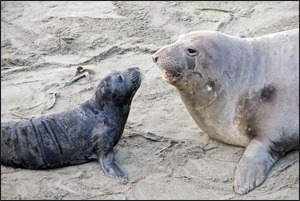
Mother and pup pair. Females and newborns are called cows and pups. Females first reproduce around age 4 and give birth to a single pup each year. When females first arrive on the beach for breeding they weigh about 500 kg. The pups are 40 kg at birth but can gain 100 kg in one month before being weaned.
January 5, 2009 at San Luis Obispo County, California. Image courtesy photographer - Joe McKenna.
Permission granted according to Creative Commons Attribution-Noncommercial 2.0 Generic
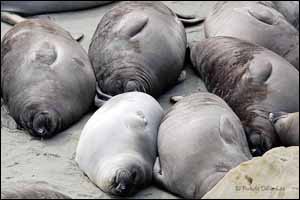
Snoozing weaners at San Simeon. A group of individuals on land is called a colony. A particular location where a colony aggregates is called a rookery. A rookery is usually a breeding place for groups of birds, but in the case of elephant seals, it is also the place where they aggregate to molt. Animals such as the elephant seal are described as "gregarious" because they like to hang out in large groups with members of their own species, at least on land. Like marine birds, these marine mammals return to land to reproduce. Image courtesy photographer - Nichole Dillon-Lee.
Tagging programs

New satellite-based technologies make it possible to track animals at sea. Not only is it a boon for scientists, it allows citizen scientists to follow along too.
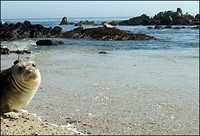
About to leave. Photographer - Jessica Meir.
Northern elephant seals have been monitored by the Tagging of Pacific Predators (TOPP) program since 2000.
TOPP
• Tagging of Pacific Predators (TOPP)• TOPP - Elephant Seals
• TOPP - Migration movies
Monitoring climate
• Elephant Seals Help Monitor Climate ChangeElephant seals that are outfitted with satellite tags can be tracked. Sensors carried by elephant seals collect and store data over time. When a tagged animal comes to the surface for a breath of air, stored data transmits upward to an orbiting satellite. Polar-orbiting satellites like the ARGOS satellite orbit the Earth in about 90 minutes. Onboard communication equipment redirects that data downward to networked computers and scientists on land and at sea.
Argos satellite system
How the satellite-based tagging and the Argos satellite system works. Animation courtesy CLS. • "Argos Keeping Track of the Planet" - BBC News• Tags used to track elephant seals - TOPP project
• Argos
The practical complexities posed by animal behavior and existing technologies pose interesting challenges for professionals across a wide range of specialties - engineers, programmers, communication specialists, and biologists. So you don't have to be a biologist to be involved in animal research or conservation efforts.
Sensors collect data as an animal swims and dives along its migration path. Basic measurements include water depth and temperature. This information helps to determine the environmental variables that are important in determining where these animals forage. By comparing data across different years, it is possible to analyze how these animals respond to differences in climate. Since these animals go to depths of the ocean that are difficult to access, it gives us a new way to monitor the ocean environment altogether.
The migration

Northern elephant seals travel into the North Pacific twice a year, in a pattern called a double migration. They go to forage and build up energy reserves that allow land-based activities while fasting for 2-4 months. Males and females travel to different hunting grounds and dine on different prey, perhaps to meet differing dietary needs. Some elephant seals feed along the way while others don't. The details are still being investigated.
Over the two migrations, northern elephant seals travel linear distances of at least ~21,000 km for males and ~18,000 km for females during 250 (males)- 300 (females) days at sea [31]. The need to return to land to breed and molt at two particular times a year constrains their migration. Females travel further and for longer on their second migration, after their molt. Overall, males travel farther than females, even though they spend less total time at sea.
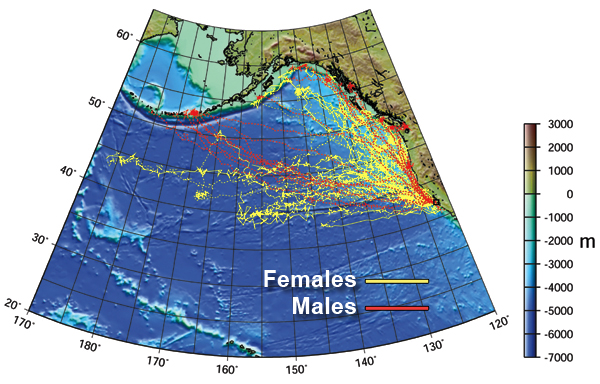
Migration range of males vs. females. Image adapted from Le Boeuf et al., 2000, copy provided by Daniel Costa and TOPP at UC Santa Cruz. [21]
TOPP near real-time animated maps
These maps allows you to see and compare the location of tagged northern elephant seals and sea surface temperature, a key climatic indicator.
Data at TOPP:
• Animated data maps - all
(scroll down to "Northern Elephant Seals")
Males and females migrate to very different places and eat different foods. Males tend to head north to northwestward along the continental margin towards the Gulf of Alaska and forage for food along the bottom (benthic environment). Females head west-northwestward and forage within the water column (pelagic environment). Scientists infer pelagic or benthic foraging preferences based on dive depth in relationship to bathymetry.
Since huge males need more food than females, yet they spend less time foraging, they may be eating not just more food, but foods that are higher in caloric content than females. Areas along the continents above the continental shelf and in the Gulf of Alaska are food-rich areas.
What do they eat?

Since no one sees what an elephant seals eats during a migration, scientists study the stomach remains of dead specimens and ones they catch-and-release. Because these specimens tend to be found close to land, their stomach contents might not represent "normal" eating that takes place during a migration.
What scientists have found is consistent with feeding in midwater and benthic environments. Their prey is dominated by deeper dwelling species that includes cephalopods, fishes and crustaceans. The cephalopods include mid- and deep-dwelling squid and octopus, the fishes include deeper and bottom-dwelling fishes such as Pacific hake (Merluccious productus), and mid-water crabs such as tuna crabs. Technically, the waters that are extremely deep for air-breathing divers, between 200-1,000 meters deep, are at midwater depths with respect to the total depth of the oceans.
Elephant seal food preferences aren't entirely clear because each new study still reveals new food preferences [28][29][30].
A few foods in the elephant seal diet
|
Pacific whiting Merluccius productus
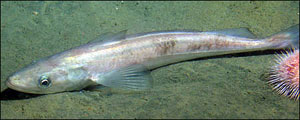 Other names: Pacific hake Lifestyle: Midwater schools and found near the bottom. Learn more: • NOAA - Fish Watch • News - Overfishing concerns • Seasonal migration of the Pacific Whiting Image source: NOAA. Image acquired July 31, 2009. Public domain. |
Spotted ratfish Hydrolagus colliei
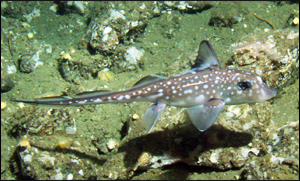 Lifestyle: Found near the bottom, from close inshore to about 913 m. Image source: NOAA. Image acquired August 3, 2009. Public domain. |
| |
|
|
Tuna crab Pleuoncodes planipes
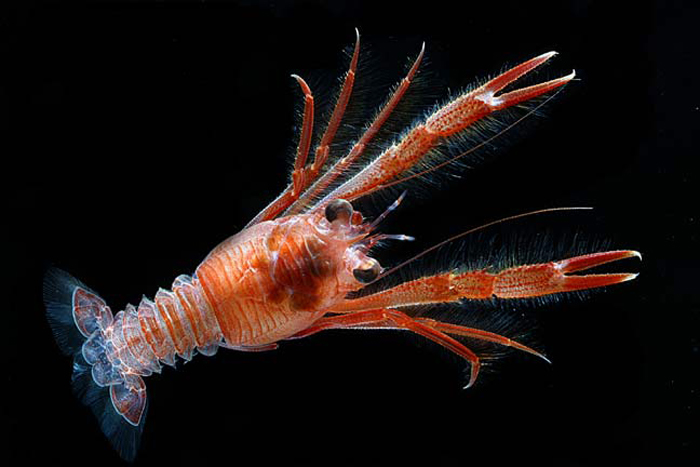 Other names: Pelagic red crab Lifestyle: Both pelagic and benthic Learn more: • Phillip Colla - photographs • SD Union Tribune - El Niño appearance Image source: Photographer – Shane Anderson. Image used with permission. |
Midwater squid Octopoteuthis deletron
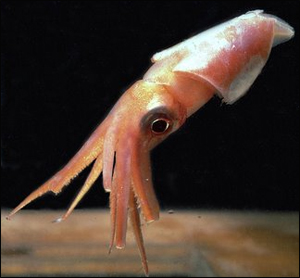 Lifestyle: Pelagic Learn more: • MBARI - movies Image source: © Richard E. Young, photograher. Image acquired Augus 3,2009 http://tolweb.org/Octopoteuthis/19839. Permission granted according to Creative Commons Attribution-NonCommercial License - Version 3.0. |